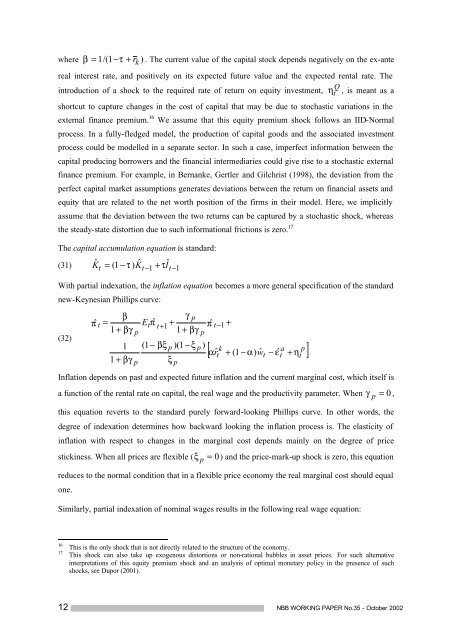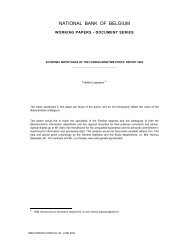An estimated dynamic stochastic general equilibrium model of the ...
An estimated dynamic stochastic general equilibrium model of the ...
An estimated dynamic stochastic general equilibrium model of the ...
Create successful ePaper yourself
Turn your PDF publications into a flip-book with our unique Google optimized e-Paper software.
where β = 1/(1−τ+ r k ) . The current value <strong>of</strong> <strong>the</strong> capital stock depends negatively on <strong>the</strong> ex-antereal interest rate, and positively on its expected future value and <strong>the</strong> expected rental rate. TheQintroduction <strong>of</strong> a shock to <strong>the</strong> required rate <strong>of</strong> return on equity investment, η t , is meant as ashortcut to capture changes in <strong>the</strong> cost <strong>of</strong> capital that may be due to <strong>stochastic</strong> variations in <strong>the</strong>external finance premium. 16 We assume that this equity premium shock follows an IID-Normalprocess. In a fully-fledged <strong>model</strong>, <strong>the</strong> production <strong>of</strong> capital goods and <strong>the</strong> associated investmentprocess could be <strong>model</strong>led in a separate sector. In such a case, imperfect information between <strong>the</strong>capital producing borrowers and <strong>the</strong> financial intermediaries could give rise to a <strong>stochastic</strong> externalfinance premium. For example, in Bernanke, Gertler and Gilchrist (1998), <strong>the</strong> deviation from <strong>the</strong>perfect capital market assumptions generates deviations between <strong>the</strong> return on financial assets andequity that are related to <strong>the</strong> net worth position <strong>of</strong> <strong>the</strong> firms in <strong>the</strong>ir <strong>model</strong>. Here, we implicitlyassume that <strong>the</strong> deviation between <strong>the</strong> two returns can be captured by a <strong>stochastic</strong> shock, whereas<strong>the</strong> steady-state distortion due to such informational frictions is zero. 17The capital accumulation equation is standard:(31) Kˆ(1 ) ˆ ˆt = − τ Kt− 1 + τIt−1With partial indexation, <strong>the</strong> inflation equation becomes a more <strong>general</strong> specification <strong>of</strong> <strong>the</strong> standardnew-Keynesian Phillips curve:(32)βpˆ t = Etπˆt+1+ πˆt−11+βγ p 1+βγ pπ11+βγp(1 − βξpξ)(1 −ξpγp)+ka p[ αrˆt + (1 −α)wˆt − εˆt + η ]Inflation depends on past and expected future inflation and <strong>the</strong> current marginal cost, which itself isa function <strong>of</strong> <strong>the</strong> rental rate on capital, <strong>the</strong> real wage and <strong>the</strong> productivity parameter. When γ p = 0 ,this equation reverts to <strong>the</strong> standard purely forward-looking Phillips curve. In o<strong>the</strong>r words, <strong>the</strong>degree <strong>of</strong> indexation determines how backward looking <strong>the</strong> inflation process is. The elasticity <strong>of</strong>inflation with respect to changes in <strong>the</strong> marginal cost depends mainly on <strong>the</strong> degree <strong>of</strong> pricestickiness. When all prices are flexible ( ξ p = 0) and <strong>the</strong> price-mark-up shock is zero, this equationreduces to <strong>the</strong> normal condition that in a flexible price economy <strong>the</strong> real marginal cost should equalone.Similarly, partial indexation <strong>of</strong> nominal wages results in <strong>the</strong> following real wage equation:t1617This is <strong>the</strong> only shock that is not directly related to <strong>the</strong> structure <strong>of</strong> <strong>the</strong> economy.This shock can also take up exogenous distortions or non-rational bubbles in asset prices. For such alternativeinterpretations <strong>of</strong> this equity premium shock and an analysis <strong>of</strong> optimal monetary policy in <strong>the</strong> presence <strong>of</strong> suchshocks, see Dupor (2001).12 NBB WORKING PAPER No.35 - October 2002
















